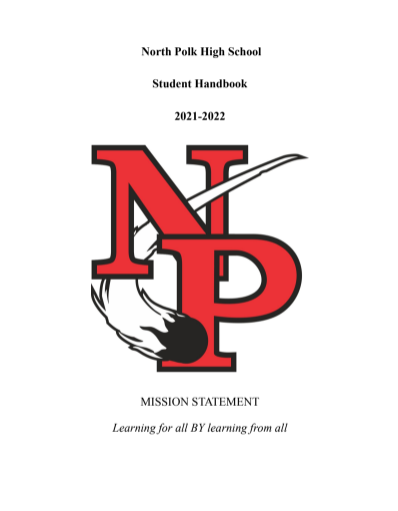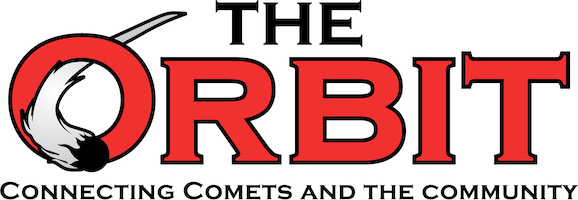Students Question the Relevance of a Seemingly Outdated Dress Code

The student handbook is home to all the information students need to behave properly. The dress code has often been the most contentious topic throughout the student body.
March 29, 2022
The high school dress code has almost always been the uniting force between students. Enemies can be united over having to take off their hoods, acquaintances may become friends after being dress coded on the same day. Scouts may report that the school administrators are on the way, jackets need to be zipped, hoods removed and shirts tugged down and pants pulled up.
School dress codes are implemented to ensure that students portray themselves in an appropriate way and deter from any distractions during designated learning time.
While this may be true, most students find that these rules are arbitrary and aid to the over-sexualization of feminine presenting students.
Rise in Dress Code Conversations
While it seems that the dress code is always a topic of contention, throughout social media and school, it seems that these conversations have increased.
Within North Polk, parents have talked about approaching the school board over gender-based discrimination within the handbook. Students share pictures of their outfits with captions sharing that they were dress coded. Arguments erupt when someone with less of a figure does not get dress coded from wearing a crop top and a curvier person does.
While the student council forms a committee every other year to read over the student handbook, it can be hard to decide where to make changes to the student dress code. When specifying how many inches that the stomach can be shown or how long an inseam has to be is very relative to the body and regulation becomes almost impossible.
Student and Teacher Complaints
*For the purposes of this section of the article, all students and teachers will remain anonymous.
When trying to find varying student opinions on the dress code, it proved to be almost impossible. It seems that the majority of the student body, as well as a select few teachers, all feel that some portion of the dress code could be altered.
Most students interviewed are frustrated of the apparent double standard when it comes to dressing coding students.
“There are boys that get to break very obvious rules while others get dress-coded for things that aren’t even in the code. I know a couple of female-presenting students that have gotten dress-coded for showing less than an inch of skin around their stomachs, while boys walk around with their underwear showing under their shorts, and “muscle shirts” in which many can see their nipples. There are also students that have been coded for not wearing a bra, which is a personal choice and, in my opinion, should not be punished,” stated one student.
Another student has similar views, “I think that the dress code itself does not objectify women, however, the enforcement of the dress code does. I have seen guys wearing muscle shirts in school, and nothing was done against that, while girls wearing crop-tops have been dress-coded frequently. While both genders have restrictions, it seems that girls are subjected to punishments more often.”
Other students put their feelings over the entire dress code in a more straightforward fashion.
“Personally I think there should be no dress code at all. I think that sexualizing and objectifying women’s bodies when it’s literally skin, that’s their problem, not ours.”
“I don’t like it because I think it sexualizes women’s bodies when they should not be sexualized by grown men in our school.”
“I would say that the school tends to objectify women more than men, since most of the time when men get dressed coded it is more what’s on the clothing as opposed to women it’s more too much skin showing.”
While many teachers did not feel comfortable speaking about the clothing choices of their students, two teachers described their feelings about the present dress code.
“I think that students should dress in a way that they’re comfortable so long as it is within a respectful and appropriate way.”
“I think that while I appreciate that dressing professionally creates a setting where maybe students are taking things a little more seriously, I also think that our dress code, as it is, unfairly targets young women. I think young women are primarily targeted within certain regulations in the dress code. I also think some dress code rules really contribute to a culture that says it’s a woman’s responsibility to cover herself up instead of a man’s ability not to look. As a mother of a son, I really don’t like that being the preeminent message that’s out to young men that if her shoulders are not covered it’s not his fault if he looks… I feel like dress is such a personal choice and students need some opportunity to express themselves through the things they wear. While I wouldn’t advocate for no dress code at all, I do think we need to have a serious conversation about how much of our dress code is about encouraging women to be ashamed of their bodies and men to bear no responsibility for their actions.”
Trends Come and Go but the Dress Code Stays the Same
While it happens that most of the dress code violations today are towards female-presenting students, it has not always been that way.
While talking to Vice Principal Rob Sinclair he noted that when he was teaching in the early 2000s male presenting students were often dress coded at higher levels due to the men’s fashion of wearing low-waisted and baggy jeans as well as hats.
With feminine fashion trends including high-waisted jeans with high cut rips and crop tops, it happens that females are getting dress-coded at higher levels than others. Often due to fashion trends, it can be taxing to find clothes that are fashionable and also fit the criteria of the dress code. Besides dress, it is also in fashion for male and female-presenting students to wear beanies or caps indoors which causes conflict with the present dress code.
Because of these conflicts that many seem outdated due to the present fashion trends, many students have alternative ideas for the enforcement or change within the dress code.
Students weighed in on how they would change the enforcement and content within the dress code, “Ideally, I would make it so people can wear what they choose as long as it does no harm to others. But I do understand the school doesn’t want to let kids do that to maintain a ‘proper’ look.”
Another student added, “I think the dress code is reasonable for students to follow, however, it isn’t enforced very well. This leads me to wonder why it’s in place at all.”
A Conversation with Mr. Sinclair
*Please note that this portion of the article was a conversation between the author and Sinclair. Some portions of the full interview have been left out due to relevance to the article subject.
Q: What are your overall opinions on the North Polk dress code?
A: I will tell you that the least favorite thing that I do is deal with the dress code…dress codes are things where there is really no right answer…I had a couple of students come in this year and they were great. We talked about it, Mr.Poldberg and I, and they said, ‘I think we should be able to allow some midsection.’ So Mr. Poldberg asked how much. Who’s going to be measuring that? They were like we don’t want it to be too much…students don’t want their principal and teachers to be staring at their midsection…it’s easier to manage, no midsection because it’s easy to see if there is a midsection.
Q: What is your decision-making process when dress coding students?
A: Every adult in the building is responsible for that rule[dress coding], it’s incredibly difficult to ask teachers to do that, they’re not looking for it necessarily, they don’t want to, they want to work with students in science and math and social studies and relationships and that. Mr. Poldberg and I are often out in the commons and if we run into it, then we deal with it. I don’t get out of my desk before school and say ‘oh it’s 8 a.m, I gotta go check dress code.’ I often say I want to go out to the commons to say good morning to the students and if I run into a student that doesn’t have appropriate dress…then I say something to them. Typically it’s just me telling them that they need to change or take your hat off. If it becomes ongoing, then sometimes behavioral referrals or detentions are assigned. My job is to follow the handbook and if I don’t do my job, then I [have] a problem.
Q: What is your response to students saying that the dress code and dress coding is objectifying toward feminine presenting students?
A: That’s a fair question. I’m not sure that it objectifies anybody, it’s just the rule. If we have a kid that is a male student that comes to school with a cut-off shirt and I see it, then they need to change…I have said to students, ‘I’m not saying there’s anything wrong with what you’re wearing, I’m not saying it looks bad, I’m not saying you can’t wear it, you just can’t wear it to school because it’s against the rules.’ To me that’s not objectifying anybody, it’s just what the rules are. If you go to Wells Fargo[the bank], I’m pretty confident that they won’t let you walk in with cut-off jean shorts, flip flops and a tank top… There are dress codes out in society. I know that schools are not exactly a place of business, but it is a place of business for us and there have to be some kinds of overall rules that usually, not everybody, collectively agrees on…It just happens to be more females now [because of fashion trends]. I dress code way more hats on males than I do females, way more, probably ten to one.
Q: What is your response to students believing that the dress code was created to stop distractions between students?
A: I’m not a high school student. Does the clothing that a person wears cause a disruption to the people around them? I don’t know. If a young man came into the school and had flip flops, no shirt and swim trunks on, and he walked into first period, would that be a distraction to class? I don’t think you could start your bellringer in class without going ‘what in the heck is so-and-so doing?’ So would it be a distraction? That’s pretty excessive…I guess my answer is I don’t know how much of a distraction it is. Could it be a distraction to some guys or some girls? Maybe? I don’t know that necessarily.
Q: Do you judge teachers for not enforcing the dress code?
A: I’m not going to judge our teachers. I know that especially the male teachers are not always comfortable with female students and the dress code, that’s a difficult thing…nobody likes that. I’m not judging our teachers, but at the same time, all of our rules are the collective responsibility of all the adults in this building… Some teachers just call me…That’s not something I’m jumping on and making a big deal about.
Q: Do you have anything else you would like to say?
A: When you gather students, they are going to say a lot of negative things about the dress code. And I understand that. My hope is to take the message from me that this is my responsibility, to uphold the rules of the handbook.
Other Dress Codes
While writing this article I became curious to see what surrounding schools have for their dress codes. I decided to add them below so readers can compare to the North Polk Dress Code.
Ankeny Centennial
https://achs.ankenyschools.org/parents/handbooks/
Students are expected to adhere to standards of cleanliness and dress that are compatible with the requirements of a good learning environment, including the wearing of a top (e.g., shirt, blouse, sweater, sweatshirt), bottom (e.g. pants, shorts, skirt, dress), and footwear
The district expects students to use good hygiene and wear clothing that is appropriate for the time, place, and occasion. Clothing or other apparel promoting products illegal for use by minors and clothing displaying obscene material, profanity, and/ or reference to prohibited conduct are disallowed. While the primary responsibility for appearance lies with the students and their parents, appearance disruptive to the education program will not be tolerated. When, in the judgment of a principal, a student’s attire substantially disrupts the educational process, constitutes a threat to health or safety, and/or contributes to a hostile or intimidating environment the student may be required to make modifications. Shoes must be worn at all times for health and safety reasons. Hats are not allowed in the classroom in grades PK-9. Exceptions may be granted by the building administration in accordance with law and policy. Students in PK-9 who would like to wear a hat or head covering for medical, religious, or other reasons should speak with their building principal.
Ballard
http://www.ballard.k12.ia.us/students/ballard-student-handbooks/
Ball caps are permitted. Hoods are not to be worn on the head. Stocking caps are not to be worn. Headbands are permitted. Bandannas are not permitted. Sunglasses are not permitted unless medically necessary. Special dress days may allow these. All of these are subject to teacher classroom policy and you may be asked to remove your hat during a specific class. 2) Shorts shall have a minimum 3.5” inseam. They will not “cup” the buttocks. (nylon athletic shorts all allowed) 3) Skirts will come to rest at mid thigh while standing. 4) Shirts and tops will fully cover the entire chest area. Shirts or tops that expose cleavage will not be permitted. 5) Midriff Rule: The belly button will not be visible. Shirts will come to rest at or near the waistline of the pants with arms at sides. 6) Pants and jeans will not have holes or tears above the 3.5” inseam mark. 7) Leggings: Must not be see-through. 8) No clothing that depicts illegal substances, sexual innuendo, degrading slogans, etc, will be tolerated.
Bondurant
https://www.bfschools.org/Page/903
Students are expected to display personal cleanliness, neatness, and appropriateness of attire at school or school activities. Examples of objectionable apparel would be items displaying: obscene or sexually suggestive words, symbols or pictures, racist and/or sexist slogans or those dealing with drugs, alcohol or tobacco. Alcohol, tobacco, or drug advertising on clothes is not appropriate school attire. Bare midriff outfits, short shorts/skirts, and hats/stocking hats/hoods are not appropriate school attire. Also not appropriate are visible undergarments and cleavage. The minimum requirements for shirts are no spaghetti straps, and shirt straps must go over both shoulders and cover all undergarments (no halter tops, shirts that tie in the back of the neck, etc.). The appropriateness of attire will be determined by the principal or the assistant principal. Students not complying with the policy regarding appropriate attire will be required to change into other clothing they have at school or change into other clothing as provided by the school, and/or receive other disciplinary action for repeated violations.
North Polk
https://www.northpolk.org/Page/2625
Students are to maintain a high degree of personal grooming and wear clothing conducive to an
educational atmosphere. While the primary responsibility for appearance rests with the students and
parents, the administration reserves the right to judge what is proper and what is not. The following will
not be considered as appropriate school attire:
- Hats, hoods, and other headwear (exceptions for religious garments).
- Clothing that exposes the mid section, open back, or chest.
- Clothing with large, open armholes exposing undergarments or mid section.
- Shirts that are cut low, especially low-cut tank tops or strapless tops, exposing chest or
undergarments.
- Clothing with alcohol, tobacco, drug advertising, or inappropriate words and phrases.


Michael Shane • May 20, 2022 at 2:17 pm
period
Addy • Apr 6, 2022 at 2:18 pm
This is really good girlboss!
Hallie • Apr 1, 2022 at 2:22 pm
Great article Olivia! I really like how you stated everything and all the different opinions you gave. #yougogirl
Keelie Maas • Apr 1, 2022 at 2:15 pm
This is such a well-written article! I like how you showed both points of view! I like how you added other dress codes too.